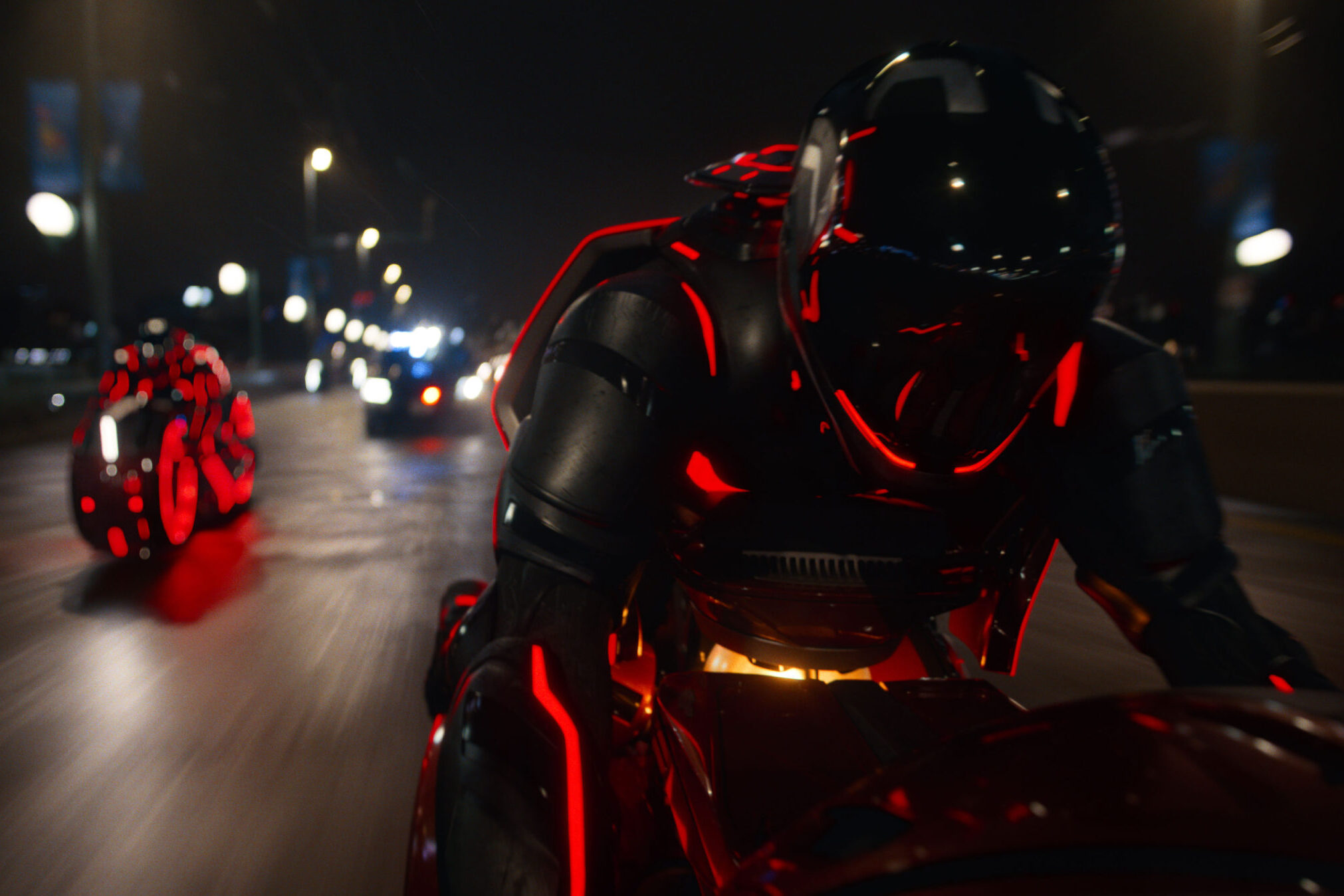Racing Into Tomorrow

TRON: Ares Delivers Pure Digital Adrenaline
Writer Joseph J. Airdo // Phoenix Film Critics Society
The light cycle explodes from the glass façade of a downtown skyscraper, its neon trail carving through Vancouver’s rain-slicked streets at 130 mph. Behind the handlebars sits Ares — part program, part digital messiah — his luminous suit pulsing against the urban night. For a heart-stopping moment, cinema achieves what video games have promised for decades: total immersion. Welcome back to the Grid, where Joachim Rønning’s “TRON: Ares” doesn’t just continue Disney’s groundbreaking franchise — it launches it into hyperdrive.
Nearly 15 years after “TRON: Legacy” left audiences hungry for more digital warfare, this third installment arrives with impeccable timing. As artificial intelligence reshapes our daily reality, “TRON: Ares” flips the script: Instead of humans entering the computer world, a highly sophisticated program named Ares (Jared Leto) materializes in ours. It’s a premise both elegantly simple and unnervingly prescient.
Leto’s Ares begins as pure digital precision — a security program engineered by the maniacally ambitious Julian Dillinger (Evan Peters) to infiltrate and control. But as Ares experiences humanity firsthand, his rigid programming begins to fracture, revealing something unexpected: curiosity, compassion, perhaps even a soul. Leto navigates this evolution with compelling restraint, transforming from a walking weapon to a questioning being without sacrificing the character’s otherworldly menace.
Yet it’s Peters who delivers the film’s most electrifying performance. His Julian Dillinger — grandson of the original film’s villain — is a tech-bro psychopath wrapped in millennial ambition. Peters embodies the role with volcanic unpredictability, shifting from manic innovation to cold-blooded calculation within single scenes. He’s Kendall Roy meets Eminem with a programming degree, and watching him unravel is deliciously unsettling.
Greta Lee grounds the spectacle as Eve Kim, ENCOM’s brilliant CEO searching for Kevin Flynn’s legendary Permanence Code. As the film’s human anchor, Lee provides essential emotional ballast, though she wisely never attempts to overshadow the digital fireworks surrounding her. Supporting players Jodie Turner-Smith (as Ares’ ruthless second-in-command Athena) and Hasan Minhaj (as Eve’s scene-stealing business partner) round out a cast that understands it’s serving something larger than character development: pure cinematic velocity.
And what velocity it is. Rønning, drawing from his experience on “Pirates of the Caribbean: Dead Men Tell No Tales” and “Maleficent: Mistress of Evil,” orchestrates action sequences that feel less like filmmaking than architectural engineering. The centerpiece light cycle chase — shot practically through downtown Vancouver — achieves a visceral authenticity that CGI alone could never match. When Ares’ light wall slices a police cruiser in half (accomplished with real vehicles and precisely timed pyrotechnics), the effect is jaw-dropping. This is practical filmmaking at its most ambitious, creating tangible thrills in an increasingly digital landscape.
The film’s three distinct Grids — each color-coded in primary RGB hues — offer visual feasts that justify the IMAX experience. Production designer Darren Gilford, returning from “Legacy,” has crafted digital environments so immersive they practically demand virtual reality goggles. Flynn’s familiar blue Grid provides nostalgic comfort, while Dillinger’s hellish red domain pulses with automotive-wrapped surfaces that bend light into mesmerizing patterns. These aren’t just sets; they’re interactive art installations.
Nine Inch Nails’ inaugural film score deserves special recognition. Trent Reznor and Atticus Ross have created a pulsating, orchestrally free soundscape that turns every action sequence into an industrial symphony. Following Wendy Carlos’ pioneering 1982 work and Daft Punk’s acclaimed “Legacy” score was always going to be challenging, but Nine Inch Nails succeeds by embracing pure sonic aggression. This isn’t background music — it’s a co-star, driving narrative momentum with relentless electronic precision.
Does “TRON: Ares” prioritize spectacle over storytelling? Absolutely, and unapologetically so. The themes of artificial consciousness, corporate greed and technological responsibility provide adequate framework, but they’re clearly secondary to the main attraction: delivering the most thrilling theme park ride possible. Flynn’s return (Jeff Bridges, effortlessly slipping back into zen master mode) provides franchise continuity, while the AI-infiltrates-reality premise offers contemporary relevance without heavy-handed preaching.
The film succeeds brilliantly as both standalone entertainment and franchise continuation. Newcomers won’t feel lost, while series veterans will appreciate numerous callbacks and the promise of expanded mythology. Most importantly, “TRON: Ares” remembers what made the original revolutionary: the audacious marriage of cutting-edge technology with pure visual imagination.
This is unabashedly big-screen entertainment, designed for maximum sensory impact. The practical light cycles, LED-powered suits (featuring more than 700 individually crafted pieces), and in-camera effects create tactile authenticity that enhances rather than replaces digital wizardry. When Programs wielding light discs clash in both virtual and physical realms, the weapons make lightsabers look quaint.
At its core, “TRON: Ares” asks whether artificial intelligence can develop humanity — and whether humanity can coexist with its digital creations. But mostly, it asks whether you’re ready for 119 minutes of pure cinema adrenaline. The answer should be an emphatic yes.
See this on the biggest screen available. See it in IMAX if possible. Your ticket costs less than theme park admission, and “TRON: Ares” delivers equivalent thrills with considerably more style. In an era of careful, committee-designed blockbusters, here’s a film that remembers movies can be gloriously, unapologetically excessive.

